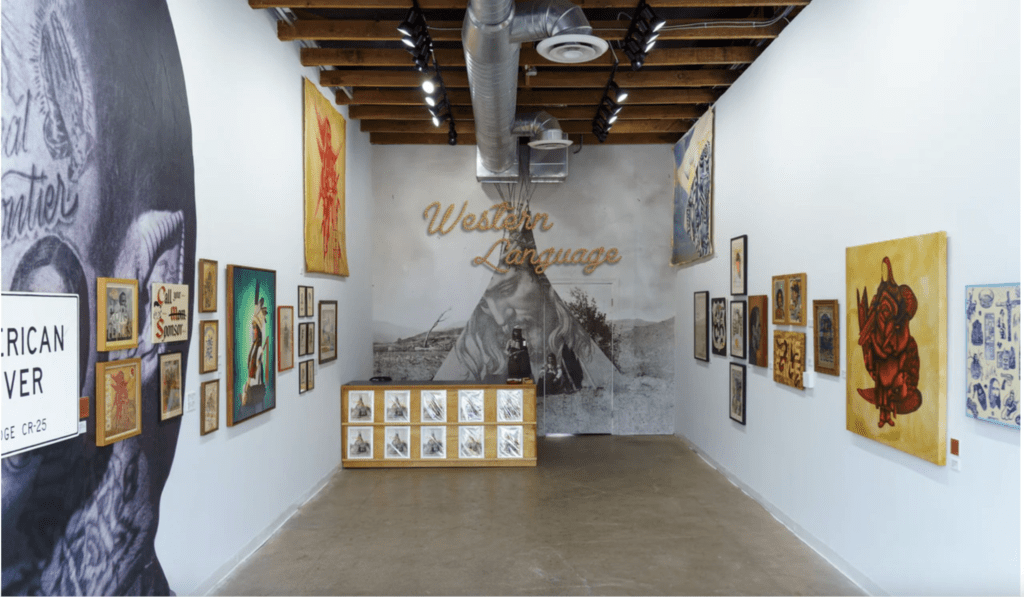Sandra Hale Schulman
ICT
The latest: Art that speaks its own language, Sequoyah stars in Cherokee, market comes in from the cold
ART: Analog art goes West
Known coast-to-coast and online for his viral “Shopped Tattoos” series in which he photoshops meaningful tattoos onto famous and infamous faces, and his ongoing wheat paste project “Pasting the West,” of large-scale images on buildings and museums, Cheyenne Randall has a new solo exhibit “Western Language” through Dec. 20 that explores Native identity, pop culture, and Americana. His online handle is @indiangiver.

For decades, Randall has worked across several mediums starting with digital collage then to large-scale mural work. I learned of him when he was chosen to create the vinyl album artwork for a cover of Peter La Farge’s “Drums” by Floyd Westerman and John Densmore that I produced in 2014.
This exhibit shows his return to brush and canvas, created in his garage studio, away from computer screens. The result combines nostalgia, resilience and Native pride.
“Western Language” honors Randall’s lineage as an enrolled member of the Cheyenne River Sioux Tribe and evokes a broader conversation about what modern Native art can be. The work is a “shellacked snapshot of Americana,” in the artist’s words. Indian chiefs, roses, horses and religious symbols float across the work like an Americana road trip.
“‘Western Language’ is a ‘hello’ from a place in my life that was formed and affected by a time of running; a world of old nostalgic dreams and a need for instant gratification,” Randall said. “For too many years, I turned my back on the brush and canvas playing with pixels and creating through a screen. Alas, I finally have the patience to sit and paint. Paint what I see and paint what I remember.
“Since 2020, and the collective implosion of culture, I found my peace in a garage studio removed from my phone, likes, comments and algorithms where ‘Western Language’ has taken form. This body of work is my shellacked snapshot of Americana and of my native pride. My wish is for viewers and collectors to walk away with a new sense of what ‘Contemporary Native Art’ is.”
MUSEUMS: Historical museum grows with the times

During the recent Association of Tribal Archives, Libraries and Museums conference, we took a trip into downtown Cherokee, North Carolina, to see the newly redesigned, and in progress, Museum of the Cherokee People. Established in 1948, the museum is one of the longest-operating tribal museums in the country, located in the sovereign land of the Eastern Band of Cherokee Indians and ancestral homelands of all Cherokees. The museum shares the history, culture and stories of the Cherokee people through its exhibitions, collections and programs.
Sequoyah, the Cherokee linguist, is featured prominently for creating a written system for the Cherokee language called the syllabary. This system of 86 characters allowed for the rapid spread of literacy among the Cherokee people, which led to books, a newspaper and a flourishing of written tradition for the tribe.
The museum features permanent and rotating exhibits, currently showing
“sov·er·eign·ty: Expressions in Sovereignty of the Eastern Band of Cherokee Indians,” which illuminates the complexities of tribal sovereignty and the Eastern Band’s continued resilience.
Featuring objects sourced from the museum collections, “sov·er·eign·ty” is designed to educate about the Eastern Band’s autonomy, relationship with the federal government, and how the tribe has defined its own relationship with its land, people and culture. The museum has permanent diorama displays of the Trail of Tears, some beautiful, recently uncovered stained-glass portraits of historical figures, and a gift shop with upscale items featuring its newly designed water spider logo.
Curator Anna Chandler explained the evolution of the museum from one room under an inn in 1948 to an ambitious future with a large new state-of-the-art building and café.
The downtown is lively, anchored around the Oconaluftee River with many blocks of shops, galleries, a living village, and a stellar amphitheater history show “Unto These Hills.”
ART MARKET: Holiday shopping from top artists

The 20th annual Winter Indian Market will take place Nov. 29-30 at the Santa Fe Convention Center.
The jam-packed weekend of art, culture and community will feature over 160 juried Native artists with one-of-a-kind handmade artwork across SWAIA’s diverse art categories — from pottery and jewelry to textiles and paintings — just in time for the holiday season.
With Santa’s Fe picturesque winters, visitors to the Winter Indian Market will get to talk to the artists and explore Native art.

